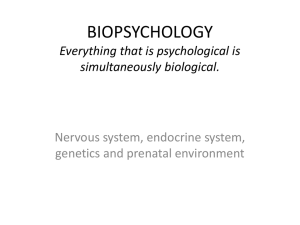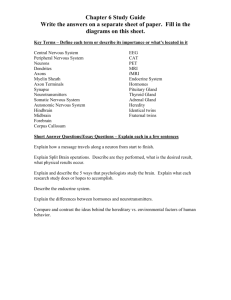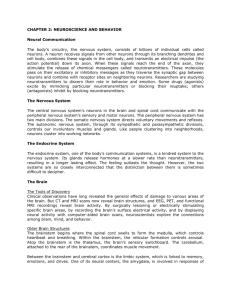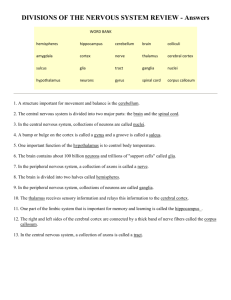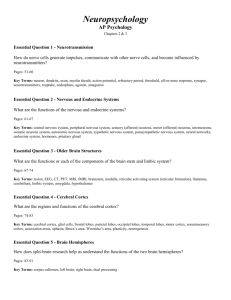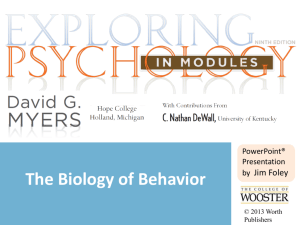BIOPSYCHOLOGY notes
advertisement
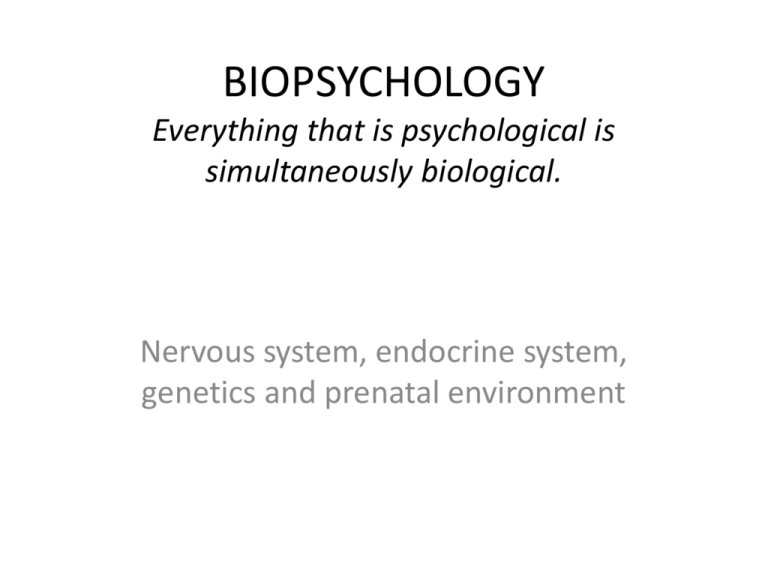
BIOPSYCHOLOGY Everything that is psychological is simultaneously biological. Nervous system, endocrine system, genetics and prenatal environment DIVISIONS OF THE NERVOUS SYSTEM • Central nervous system • Peripheral nervous system DIVISIONS OF THE NERVOUS SYSTEM • Somatic nervous system • Autonomic nervous system DIVISIONS OF THE NERVOUS SYSTEM • Sympathetic nervous system • Parasympathetic nervous system • Think: “para-” chute as it slows you down. Nervous System • Steps of the neural chain Neurons: the cells that make up the nerves Part Definition Function A. dendrites Bushy fibers of one end of the neuron that receive information Are stimulated into activity by neurotransmitters B. axon Pass the information through the cell from the dendrites C. myelin sheath Layer of fatty tissue that insulates the axon of some neurons The path of the electrical impulse (action potential) thru neuron Speeds the electrical impulse down the axon; degenerated by multiple sclerosis D. axon terminal The end of the neuron E. synapse F. vesicles Upon stimulation it released neurotransmitters into the synapse or takes them back up (reuptake) The tiny gap between dendrites and The space btw where the axon terminals neurotransmitters move from axon terminal to dendrites Tiny, near spherical packets within Stores the NT until the action the axon terminal that contain high potential triggers its release concentrations of neurotransmitters into the synapse Types of Neurons • Sensory (afferent) vs. Motor (efferent) neurons: • Sensory/afferent neurons take messages away from sensory organs to the brain. • Motor/efferent neurons take messages from the brain to the muscles resulting in motor tasks. • Interneurons: central nervous system neurons that internally communicate and intervene between the sensory inputs and motor outputs. We have billions and billions of these. Neural communication in the cell • Neurons are either excited or inhibited and it is “all or nothing”…most votes wins! Neural communication in the cell • When “excited” an electrical impulse called an action potential travels down the axon and it is propagated by the opening and closing of sodium and potassium “gates.” Neural communication between cells • A synapse (gap) exists between an axon and a neighboring dendrite. When stimulated the axon terminal will release neurotransmitters into the synapse wear they will travel to excite the next neuron. Neurotransmitters Neurotransmitter Effect Norepinephrine Epinephrine Helps control alertness and arousal; compliments adrenalin NT that functions to speed up body processes, is highly arousing, chemically identical to adrenalin but is released by neurons. Endorphins “endogenous morphine” natural opiates that are released in response to pain and vigorous exercise; an inhibitory NT resulting in pain reduction and pleasurable feelings Plays a role in learning and memory. Messenger between a motor neuron and a skeletal muscle. Allows for the contraction of muscles. 90% depletion of ACH in ppl with Alzheimer’s disease. An inhibitory NT. It is strongly associated with our reward system. If it feels good, it probably involves dopamine. Excessive activity at dopamine receptors has been linked to schizophrenia; reduced is associated with Parkinson’s disease. Affects mood, hunger, sleep, and arousal. Prozac and similar anti depressants raise serotonin activity and reduces feelings of anxiety. NT that functions almost always as an neural inhibitor; it helps you Acetycholine (ach) Dopamine Serotonin GABA Chemically Manipulating NT’s • AGONIST: A molecule that mimics the effects of a NT or blocks the reuptake of a NT so the effects are prolonged. Agonists excited neurons. • Ex: The venom of a black widow spider acts as an ACH agonist, leading to painful muscle contractions, convulsions, and possible death • • ANTAGONIST: A molecule that inhibits a NT release. EX: Botulin, a poison that can form in improperly canned foods, causes paralysis by blocking ACH release from a sending neuron. (Botox works the same way, reducing wrinkles.) Research has shown that your mood is influenced in part by the amount of serotonin receptor binding. When you are happy, it is likely that you have more serotonin receptors activated. Positive events in your life (like falling in love, perhaps) cause greater serotonin release, increasing receptor binding. After a little while the serotonin molecule will detach ("unbind") from the recepter and float back into the synapse. When this happens, the receptor stops sending chemical signals to the cell body, and it waits for another serotonin molecule to come along. (Those yellow things on the membrane of the axon terminal are serotonin reuptake transporters.) About an hour or so after you take Ecstasy (the peak experience) When you take Ecstasy, the vesicles release enormous amounts of serotonin into the synapse. This significantly increases serotonin receptor binding (more serotonin in the synapse means a greater chance for some of them to bind to the receptors). This increased receptor activity leads to significant changes in the brain's electrical firing and is primarily responsible for the MDMA experience (i.e. empathy, happiness, increased sociableness, enhanced sensation of touch, etc.). Notice that there is some dopamine in the synapse as well (the blue things). MDMA also causes dopamine release (from dopamine cells). As you can see, dopamine receptors have also been activated. Long term effects • Research has shown people who have once used MDMA regularly have measureable degrade in memory function, attention problems, and impaired executive function such as decision making and planning. They also measure within range to be diagnosed with depression. • Data is statistically significant (likely not due to chance) BUT confounding variables such as alcohol use and use with other drugs as well as the fact that these a self-reports, not necessarily a representative sample make it difficult to draw causal conclusions. ENDOCRINE SYSTEM GLAND/ORGAN LOCATION FUNCTION Hypothalamus Pituitary gland Brain Brain Controls the master gland, pituitary Secretes many different hormones which regulate the other glands Thyroid Neck Controls metabolism Adrenal glands Attached to kidneys Release adrenalin which regulates heart rate, respiration, “fight or flight” Pancreas Near the stomach Regulates level of sugar in the blood Ovary Lower abdomen of women Secretes female sex hormones (estrogen/progesterone) Testes Testicles Secretes the male sex hormone testosterone ENDOCRINE SYSTEM Hormones vs. Neurotransmitters • Some hormones, like adrenaline, are chemically like neurotransmitters. Therefore, hormones & NTs function in very similar ways. • They differ in processing speed: NTs communicate very rapidly and hormones move much more slowly throughout the body. • But even though it takes longer for hormones to have their effect, the effect is often more long lasting. • Brain > pituitary gland > other glands > hormones > brain The BRAIN The brainstem consists of the medulla, pons, and reticular formation. Part of the brain Location Purpose/function Medulla (aka medulla oblongata) Top of the spinal cord, located in the skull Basic life sustaining functions: heart beat, breathing, vomiting , salivation, coughing, & sneezing; damage here is frequently fatal Pons Anterior to (to the front of) the medulla Reticular formation Within the medulla & pons Latin for “bridge”, origins of cranial nerves that cross from left to right sides of the brain. Involved with communication between the cerebellum and the cerebral cortex. Network of neurons that filters incoming stimuli to other areas of the brain; controls arousal THE BRAIN The thalamus sits atop the brainstem and the cerebellum is located to the rear of the brainstem. Part of the brain Cerebellum Thalamus Location Purpose/function Rear of brainstem, base of brain top of brainstem “little brain” coordinates voluntary movement, enables one type of nonverbal learning & memory; Receives information from all sense (except smell) & routes to higher brain regions; also receives info from brain that goes to cerebellum & medulla THE BRAIN The limbic system lies on the border of the brain’s older evolutionary parts and the most advanced cerebral hemisphere. Hypothalamus Below the thalamus Amygdala Hippocampus Monitors blood chemistry, controls the pituitary gland (master gland); key to motivated behaviors such as hunger, thirst, sexual drive, fight or flight… Top of brainstem Influences aggression and fear, activated by emotions Top of brainstem Keeps track of memories THE BRAIN The cerebral cortex is the outer layer of the brain’s hemispheres. It is the body’s control and informationprocessing center. Lobes Occipital lobe Parietal lobe Temporal lobe Frontal lobe Purpose/function Rear areas of the cerebral cortex; vision center Top to rear area of the cerebral cortex; includes the sensory cortex Side area of the cerebral cortex (above ears); hearing Front area of the cerebral cortex; speaking and motor activities, higher order thinking such as planning, judging, problem solving OTHER CORTICAL AREAS (Other areas of the cerebral cortex) • Association area (cortex): any of the various areas of the cerebral cortex that are not involved primarily in sensory or motor function. • Broca’s area: area of the frontal lobe associated with the control of speech. (Think “boca”=mouth in Spanish) • Wernicke’s area: area association with the interpretation of sound • Aphasia: loss or impairment of the ability to understand language or express oneself through language due to injury or illness. Illustration of brain structures involved in making conversation. The Anatomy of the Brain • http://www.gwc.maricopa.edu/class/bio201/ brain/brshpx.htm THE BRAIN Corpus callosum Left hemisphere Right hemisphere Band of neural fibers that connecting the two brain hemispheres and carrying messages between them Controls the right side of the body, primary location for speech (Broca’s area), also specialized for math ability, calculation, and logic Controls the left side of the body, visual & spatial relations, perception is primarily processed here, music & art better understood on this side of the brain, creativity and intuition are also found here. THE BRAIN • ** The idea that we are “left” or “right” brained has been over simplified by “pop” psychology articles. We all use both sides of our brains and anyone who has sustained damage to one or both sides of the brain shows remarkable compensation made by the opposing side. • “wax on, wax off” activity BRAIN SCANS Test EEG What does it stand for? Electroencephalogram Lesions CAT Computed tomography PET Positron emission tomography MRI/ fMRI Magnetic resonance imaging How does it work? Reading of electrical waves traveling across the brain Removal or damage to selected brain matter When is it used? Stimuli evoke electrical impulses which will be picked up by the EEG Animal studies, biopsies, removal of damaged tissue x-ray photographs Identify head trauma, fractures Shows areas of chemical Research which parts of “consumption” (glucose) the brains are active or w/radioactive tracers inactive by following the tracers Magnets align neural See the soft tissue and atoms which give off fluid areas of the brain signals when returning and the blood flow to normal BRAIN SCANS GENETICS & HUMAN BEHAVIOR Behavioral geneticists study our differences and weigh the relative effects of heredity and environment. NATURE VS. NURTURE Genetically, all humans are 99.9% identical. It is the .1% in conjunction with varying environmental factors that makes us all unique. Human traits are influenced by gene complexes meaning multiple genes play a role in height, intelligence, temperament, etc. GENETICS & HUMAN BEHAVIOR • TWIN STUDIES Identical >> Fraternal Genetics & Behavior • Identical twins share identical genes and very similar developmental environments • Fraternal twins share 50% of the same genes and very similar developmental environments • Separated identical twins share identical genes but very different developmental environments. Genetics & Behavior • Research shows that identical twins are much more similar behaviorally than non-identical twins. • Lykken & McGue found that you are 5.5 times more likely to divorce if your identical twin had divorced. • Loehlin & Nichols found identical twins to be more similar in abilities, personal traits, and interests, regardless of parental treatment. Genetics & Behavior • Genetically identical twins reared apart in different families have consistently shown significant similarities in personality, interests, and behaviors. Those reared together are even more similar. • Genetically identical twins reared apart have more in common than fraternal twins reared apart. • Though some researchers feel this may be all due to “chance,” (Besides, how many sets of identical twins reared apart actually exist?) adoption studies strengthen the genetic argument in that adopted children are often NOT similar to their adoptive parents. Nature vs. Nurture • “Nurture works on what nature endows.” • Example: Some people are physiologically more prone to eating disorders, but the environment/culture to which they are exposed can/will enhance their chances or developing an eating disorder. • What implications does knowing one’s genetic make up and “risk” factors have for our future? Behavioral geneticists vs. Evolutionary psychologists • Behavioral geneticists are interested in what makes us unique and in how and why we differ from one another. • Evolutionary psychologists focus on how we are alike as humans, what commonalities we share. – All people in all cultures show favor to sweet and fatty foods because the consumption of these are beneficial to survival of famine. Unfortunately, today famine is not often a risk factor, yet we still are driven to consume fatty foods >> obesity. Mean Genes is a book by Drs. Terry Burnham and Jay Phelan that explores the genetic explanations for our behaviors such as spending habits, eating habits, intimacy, and mating. Environmental Factors • Prenatal environment: prenatal care, placentas, etc. • Enriched environment: “Those with the most toys win!” Without exposure to written or signed language prior to adolescence one will never master it. • Parenting: Has its greatest influence when extreme (abusive, neglectful, etc.) • Peer Influence: The selection of peers makes it powerful. A child is more likely to become a smoker if peers smoke but not if parents smoke. • Parent decisions (like where to live) will influence peer selection.

